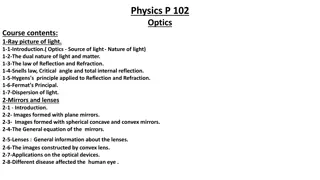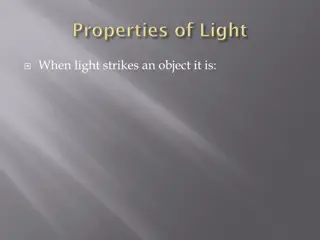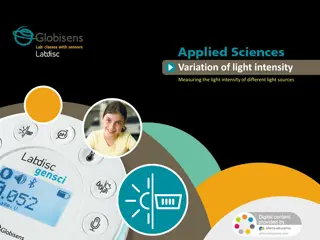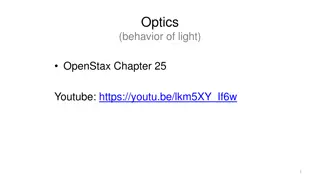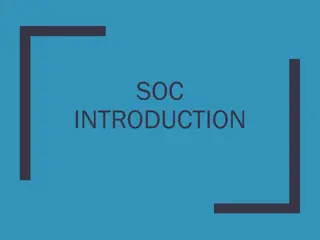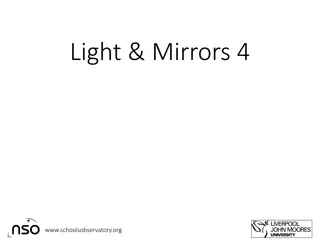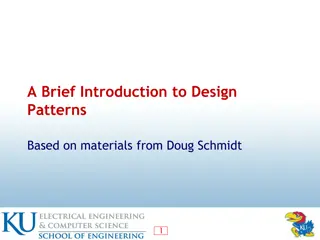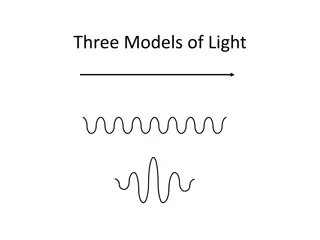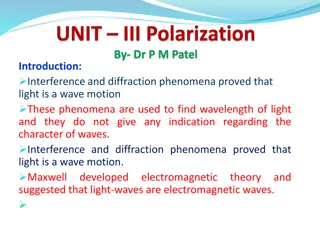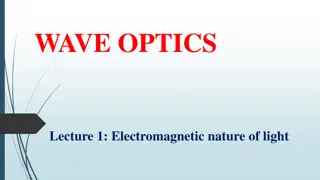Understanding Software Analysis and Design Process
Software analysis and design involve a systematic approach to understanding user requirements, creating logical models, and transitioning to detailed design specifications. Requirements analysis focuses on capturing system requirements, while design translates these requirements into implementation
7 views • 16 slides
Exploring Optics: Light Behavior and Properties
Optics studies the behavior of light, its interaction with matter, and the construction of instruments using or detecting light. From the dual nature of light to the laws of reflection and refraction, this branch of physics delves into topics like mirrors, lenses, and the dispersion of light. Practi
2 views • 15 slides
Understanding Prism Terminology and Light Deviation
Prisms are optical devices that deviate light without changing its vergence. This module explores the various terminology associated with prisms, including Apex, Base, Refracting Angle, and Angle of Deviation. The passage of light through a prism follows Snell's Law, where the ray is deviated toward
4 views • 42 slides
Understanding Diffraction of Light: Types and Distinctions
The propagation of light according to the wave theory involves diffraction, where light waves exhibit bending around obstacles, causing a decrease in intensity. There are two main types of diffraction - Fresnel's and Fraunhofer's, each characterized by different conditions and behaviors. The distinc
1 views • 7 slides
Workers Compensation Solutions for Light Duty Job Assignments
Learn effective solutions for Workers Compensation Light Duty job assignments. This guide provides strategies to create and implement light-duty roles, helping injured employees return to work safely and efficiently. Understand essential benefits and best practices for managing light-duty assignment
9 views • 4 slides
Guidelines for Design of Cement Concrete Pavement and Interlocking Paver Blocks
This document provides guidelines for designing cement concrete pavements and interlocking paver blocks, covering factors governing design, wheel loads, design period, subgrade characteristics, approximate k values based on CBR values, and the importance of a sub-base below concrete pavements. It em
0 views • 67 slides
Understanding the Interaction of Light with Objects
When light strikes an object, it can be reflected, transmitted, or absorbed, depending on the material of the object. Transparent materials allow light to pass through, translucent materials scatter light, and opaque materials absorb and reflect light. The color of objects is the color they reflect,
6 views • 17 slides
Overview of Optical Fibre Technology and Applications
Optical fibre technology, spearheaded by Dr. Prabodh Sahai Saxena, revolutionizes communication systems through light transmission. This cutting-edge technology utilizes fibre optics made of glass or plastic to carry light signals, offering advantages like high bandwidth, low signal loss, and no ele
0 views • 20 slides
Software Engineering Design Principles and Concepts
The chapter discusses the essential principles and concepts in software design, highlighting the four key design models - data design, architectural design, interface design, and component-level design. It emphasizes the importance of traceability to the analysis model, minimizing the gap between so
0 views • 36 slides
Evolution of Light Theory: From Wave Theory to Quantum Theory
At the turn of the century, the discovery of the photoelectric effect challenged the wave theory of light, leading to the development of the quantum theory by Max Planck and Albert Einstein. This new theory introduced the concept of discrete energy units known as quanta, bridging the gap between wav
1 views • 62 slides
Light Tracking Servo System Using Cadmium Sulfide Resistors
Introduction to an Arduino-based light tracking system using Cadmium Sulfide light-dependent resistors. The system tracks the maximum light intensity and automatically adjusts its direction towards the brightest source. It includes an Arduino-based Lux Meter and specifications such as DAC resolution
0 views • 7 slides
Ethical Approaches in Journalism: Red Light vs. Green Light Ethics
Explore the contrasting perspectives of Red Light and Green Light ethics in journalism, where Red Light focuses on caution and restraint while Green Light emphasizes action and opportunity. Dive into the nuances of ethical decision-making in journalism and consider the impact of language on ethical
0 views • 13 slides
Understanding Light Intensity Variation in Different Sources
Explore the correlation between light intensity and efficiency in various light sources through an intriguing experiment. Delve into the theoretical framework and practical applications to grasp the essence of light intensity and its distribution. Uncover the factors influencing the efficiency of li
0 views • 21 slides
Understanding Young's Double-Slit Experiment and Interference Patterns
Thomas Young's double-slit experiment in the late 1700s provided evidence of light behaving as a wave, showcasing interference patterns. This experiment challenged the particle theory of light and supported the wave theory. The interference patterns observed helped scientists grasp the wave nature o
0 views • 27 slides
Understanding Light Intensity: Measuring Different Light Sources
Explore the concept of light intensity by measuring various light sources and their efficiency. Through practical experiments, understand the relationship between light intensity and the output of different light sources. Theoretical frameworks, practical applications, and key concepts are discussed
0 views • 21 slides
Understanding Light: Basic Properties and Interactions
Explore the fundamental properties of light such as its speed compared to sound, the formation of shadows, and how we see things through reflection. Dive into types of light interactions like refraction and reflection, understanding how light behaves when passing through different mediums and intera
0 views • 27 slides
Understanding Light, Shadows, and Reflection in Science
Light is a vital form of energy that helps us see objects. Luminous objects emit light, while non-luminous objects do not. Understanding how light interacts with objects, creating shadows and reflections, is crucial in science. Transparent objects allow light to pass through, translucent objects all
0 views • 13 slides
Understanding Light: Key Concepts for Year 3 Students
Delve into the world of light with Year 3 students through engaging activities and explorations. Learn about sources of light, shadows, reflective surfaces, and the importance of light for vision. Discover how light helps us see and how shadows are formed, while exploring materials and objects that
0 views • 9 slides
Understanding the Behavior of Light in Optics
Light in optics can be described as a wave, a particle, or a ray. The ray model of light explains how light travels in straight lines unless it interacts with a surface or changes media. By tracing rays back, we can locate objects and understand how light interacts with matter at boundaries between
0 views • 39 slides
Understanding System on Chip (SoC) Design and Components
Explore the world of System on Chip (SoC) design, components, and working flow. Learn about Intellectual Properties (IP), platform-based design, typical design flows, top-down design approach, and the emerging Electronic System Level (ESL) design flow. Discover the essential components of an SoC, su
0 views • 45 slides
Exploring Design Inspiration and Elements in Costume and Fashion Design
Dive into the world of costume and fashion design through a visual journey of finding design inspiration, understanding the design process, emphasizing originality, and exploring different sources of creativity. Discover how technology, art, food, history, architecture, and nature can spark innovati
0 views • 45 slides
Enhancing Piping Design Efficiency with Spec-Driven Technology
Explore how Spec-Driven Piping technology powered by CADACTIVE offers a standardized approach for piping design in Creo Parametric. This innovative extension streamlines design communication, eliminates errors, and improves design efficiency by utilizing a master catalog, automated checking capabili
0 views • 15 slides
Material Design: Combining Classic Design Principles with Technological Innovation
Material Design is a design language that combines traditional design principles with the possibilities offered by technology and science. It emphasizes visual language, classic design elements, and innovation to create delightful user experiences. The Material Metaphor, Imagery, Typography, Color,
0 views • 34 slides
Comprehensive Guide to System Design Components and Techniques
System design involves the detailed planning and identification of components in an information system, aiming to provide users with a general understanding of the new system. This process includes techniques like flowcharts, prototyping, and component design, covering aspects such as output design,
0 views • 24 slides
Understanding Design Patterns: A Comprehensive Overview
Exploring the world of design patterns, this content delves into the essence of design patterns, their application in software design to resolve complexity, and the different types of design patterns - creational, structural, and behavioral. It also showcases examples of popular design patterns such
0 views • 22 slides
Exploring Light and Mirrors: Investigations and Discoveries
Delve into the world of light and mirrors as we investigate angles of reflection, examine how mirrors affect the perception of objects, and explore the use of periscopes in observing underwater. Discover the rules governing the reflection of light beams and unravel the mysteries of how mirrors manip
0 views • 11 slides
Understanding Basic Concepts in Software Design
Software design involves transforming customer requirements into a form suitable for implementation, with activities categorized into preliminary and detailed design stages. High-level design focuses on module identification and control relationships, while detailed design entails defining data stru
1 views • 24 slides
Understanding Light Emitting Diodes (LEDs)
Light Emitting Diodes (LEDs) are semiconductor devices that convert electrical energy into visible or invisible light. They are constructed using gallium, phosphorus, and arsenic materials instead of silicon or germanium. The recombination process in forward bias condition is crucial for the operati
0 views • 19 slides
Exploring 3D Design and Critical Analysis in Architecture
Dive into the world of 3D design and critical analysis with a focus on architecture. Discover the stages of design, essential skills for designers, and areas of study in three-dimensional design. Delve into iconic buildings like Frank Lloyd Wright's Falling Water, analyze their key features, and eve
0 views • 9 slides
Understanding Color: A Comprehensive Overview
Color is a fascinating aspect of our visual world, explored through the prism of science and light. This chapter delves into the origins of color perception, from Isaac Newton's study of the color spectrum to the reflection and transmission of light that determines how we see colors. Gain insights i
0 views • 28 slides
Understanding Design Patterns in Object-Oriented Design
Design patterns in object-oriented design (OOD) are essential templates that codify best practices for solving common problems. They help streamline development by capturing proven design decisions, promoting code reuse, and enhancing system flexibility and modularity. Learn about the core concepts,
0 views • 20 slides
Understanding Sources of Light and Reflection
Exploring the concept of light sources and reflection, the article delves into how light is created by various objects like the sun, light bulbs, and fires. It explains the difference between sources of light and objects that reflect light, such as shiny metal surfaces. The reader is encouraged to i
0 views • 14 slides
Exploring Models of Light: Ray Model and Wave Model
This informative content delves into the Ray Model of Light, discussing how light travels in straight lines known as rays and how it can be made visible. It also explores the Wave Model of Light, covering topics like diffraction and the reasons why we often do not notice it. Additionally, the text t
0 views • 9 slides
Understanding Light Absorption by Chlorophyll in Biology
Explore how chlorophyll absorbs light in photosynthesis, the role of different types of seaweeds, and the use of spectrometers to measure light absorption. Discover the specific light regions absorbed by chlorophyll A and B, as well as adaptations in seaweeds for varying light intensities. Learn abo
0 views • 9 slides
Understanding Interaction Design in Human-Computer Interaction
Interaction design focuses on creating interactive products that are easy, effective, and enjoyable to use. It aims to reduce negative user experiences while enhancing positive ones. Designing interactive products requires understanding user activities, interfaces, and device arrangements to support
0 views • 11 slides
Investigating the Role of Light in Photosynthesis
Explore the significance of light in photosynthesis through a structured scientific investigation involving plants, testing the necessity of factors like carbon dioxide, water, and light. Follow a hypothesis-driven approach to observe the production of oxygen in plants exposed to light versus dark c
0 views • 12 slides
Understanding Light: How We See and Interact with Objects
Explore the fascinating world of light and vision, from how light travels in straight lines to how we perceive objects. Learn about luminous and nonluminous objects, the different categories of light sources, and the vocabulary associated with light interactions. Delve into the concepts of emitting,
0 views • 7 slides
Factors Affecting Algal Ecology: Light Intensity Impacts on Algae Growth and Composition
Light intensity plays a crucial role in the growth and composition of algae. Algae undergo photoadaptation processes to adjust to varying light levels, affecting their photosynthetic efficiency and cellular properties. High light intensity can lead to photoinhibition and changes in cellular composit
0 views • 19 slides
Understanding Light Wave Polarization and Brewster's Law
Interference and diffraction phenomena demonstrate light as wave motion, leading to insights on wave nature. Maxwell's electromagnetic theory supports light as transverse waves. Learn about polarization of light waves, production methods, and applications in industry. Explore the discovery of light
0 views • 89 slides
Understanding the Electromagnetic Nature of Light in Wave Optics
Exploring the electromagnetic properties of light, this lecture covers the dual nature of light as both a wave and particles, the quantized particle nature of light known as photons, and the manifestation of the electromagnetic nature of light through Maxwell's equations. It delves into wavefronts,
0 views • 8 slides

